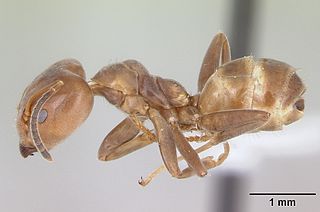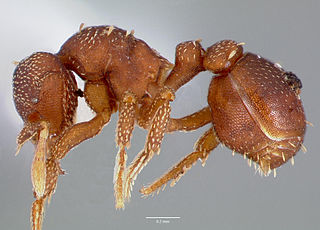
Megalomyrmex is a genus of ant in the subfamily Myrmicinae. The genus is known only from the Neotropics, where some of the species are specialized parasites or predators of Attini.
Pheidole branstetteri is a species of ant in the genus Pheidole. It was discovered and described by Longino, J. T. in 2009.
Pheidole carinote is a species of ant in the genus Pheidole. It was discovered and described by Longino, J. T. in 2009.
Pheidole gymnoceras is a species of ant in the genus Pheidole. It was discovered and described by Longino, J. T. in 2009.
Pheidole rhinomontana is a species of ant in the genus Pheidole. It was discovered and described by Longino, J. T. in 2009.

Procryptocerus is a Neotropical genus of gliding ants, with the ability to "parachute" by steering their fall if they drop off of the tree they were on.

Cryptopone is a genus of ponerine ants containing 23 valid species, all of which are extant. The genus has a worldwide distribution, with most species occurring in Asia. Workers range from very small to medium in size (1.7–6.1 mm), with the queens being slightly larger. Wadeura was previously synonymized under this genus, however, its two species were separated out again by Branstetter & Longino, 2022.

Cyphomyrmex is a genus of fungus-growing ants found primarily in South and Central America. However, some species do come up to the southern portion of North America. They grow a variety of fungi in the tribe Leucocoprineae. Most fungal gardens are grown in small nodules, some species to cultivate entire mycelium, though. Colonies are monogynous and are relatively small with about 100 workers on average.

Rhopalothrix is a genus of ants in the subfamily Myrmicinae.

Azteca is a strictly Neotropical genus of ants in the subfamily Dolichoderinae. The genus is very diverse and contains around 84 extant species and two fossil species. They are essentially arboreal and many species have mutualistic associations with particular plant species, where the genus Cecropia presents the most conspicuous association. In the Brazilian Amazonia, Azteca species are associated with species of Codonanthopsis.

Bothriomyrmex is a genus of ants in the subfamily Dolichoderinae.

Leptanilloides is a genus of ants in the subfamily Dorylinae. Leptanilloides is an uncommonly collected genus with subterranean habits in the New World Andean and sub-Andean tropics.

Adelomyrmex is a genus of ants in the subfamily Myrmicinae. Species of Adelomyrmex are small, litter-inhabiting ants most often collected in Berlese and Winkler samples. Although the genus and its relatives have a pantropical distribution, Central American cloud forests are the only places where they are abundant and diverse. Including undescribed species, Adelomyrmex has 66 species as of 2023.

Octostruma is a genus of ants in the subfamily Myrmicinae. The genus is found in the Neotropics.

Eurhopalothrix is a genus of ants in the subfamily Myrmicinae.

Propodilobus is a genus of ants in the subfamily Myrmicinae. It contains the single species Propodilobus pingorum, known only from two localities on Borneo, Sarawak, Malaysia.

Stenamma is a genus of cryptic leaf-litter ants that occurs in mesic forest habitats throughout the Holarctic region, Central America, and part of northwestern South America.

Myrmelachista is a Neotropical genus of ants in the subfamily Formicinae. The genus is found exclusively in the Neotropical realm. Little is known regarding their biology.

Syscia is a genus of ants in the subfamily Dorylinae containing thirty eight described species. The genus is distributed widely across the Eastern Asia, North America, and South America. Syscia was described by Roger (1861), later placed as a Cerapachys subgenus by Wheeler (1902) and then junior synonym of Cerapachys by Kempf (1972). Syscia was resurrected as a valid genus by Borowiec (2016) during redescription of the doryline genera.

Ponerini is a tribe of ponerine ants with 46 genera and 6 extinct genera. It contains every ponerine genus except Platythyrea, which is placed in its own tribe Platythyreini.















